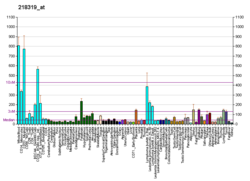| PELI1 |
|---|
|
| Identifiers |
|---|
| Aliases | PELI1, pellino E3 ubiquitin protein ligase 1 |
|---|
| External IDs | OMIM: 614797; MGI: 1914495; HomoloGene: 23243; GeneCards: PELI1; OMA:PELI1 - orthologs |
|---|
| Gene location (Human) |
|---|
 | | Chr. | Chromosome 2 (human)[1] |
|---|
| | Band | 2p14 | Start | 64,092,652 bp[1] |
|---|
| End | 64,144,420 bp[1] |
|---|
|
| Gene location (Mouse) |
|---|
 | | Chr. | Chromosome 11 (mouse)[2] |
|---|
| | Band | 11 A3.1|11 13.81 cM | Start | 21,041,291 bp[2] |
|---|
| End | 21,100,323 bp[2] |
|---|
|
| RNA expression pattern |
|---|
| Bgee | | Human | Mouse (ortholog) |
|---|
| Top expressed in | - mucosa of paranasal sinus
- cartilage tissue
- mucosa of pharynx
- amniotic fluid
- skin of thigh
- vena cava
- oral cavity
- human penis
- bone marrow
- epithelium of nasopharynx
|
| | Top expressed in | - medial ganglionic eminence
- blood
- mesenteric lymph nodes
- left lung lobe
- transitional epithelium of urinary bladder
- nucleus accumbens
- skin of external ear
- olfactory tubercle
- Rostral migratory stream
- anterior amygdaloid area
|
| | More reference expression data |
|
|---|
| BioGPS |  | | More reference expression data |
|
|---|
|
| Gene ontology |
|---|
| Molecular function | - ubiquitin-protein transferase activity
- protein binding
- ubiquitin-ubiquitin ligase activity
- protein serine/threonine kinase activity
- transferase activity
- ubiquitin protein ligase activity
| | Cellular component | | | Biological process | - response to dsRNA
- positive regulation of toll-like receptor 3 signaling pathway
- positive regulation of cytokine production
- protein polyubiquitination
- negative regulation of T cell proliferation
- response to lipopolysaccharide
- positive regulation of B cell proliferation
- protein ubiquitination
- positive regulation of toll-like receptor 4 signaling pathway
- positive regulation of I-kappaB kinase/NF-kappaB signaling
- positive regulation of B cell activation
- negative regulation of NF-kappaB transcription factor activity
- positive regulation of protein ubiquitination
- negative regulation of T cell activation
- protein phosphorylation
- immune response
- Toll signaling pathway
- protein K48-linked ubiquitination
- interleukin-1-mediated signaling pathway
- proteasome-mediated ubiquitin-dependent protein catabolic process
- negative regulation of necroptotic process
- protein K63-linked ubiquitination
- regulation of Toll signaling pathway
| | Sources:Amigo / QuickGO |
|
| Orthologs |
|---|
| Species | Human | Mouse |
|---|
| Entrez | | |
|---|
| Ensembl | | |
|---|
| UniProt | | |
|---|
| RefSeq (mRNA) | | |
|---|
| RefSeq (protein) | | |
|---|
| Location (UCSC) | Chr 2: 64.09 – 64.14 Mb | Chr 11: 21.04 – 21.1 Mb |
|---|
| PubMed search | [3] | [4] |
|---|
|
| Wikidata |
| View/Edit Human | View/Edit Mouse |
|















